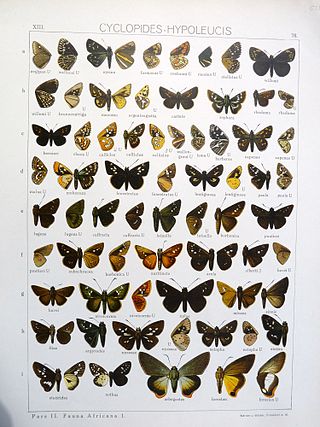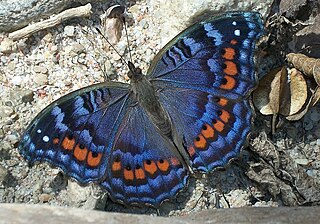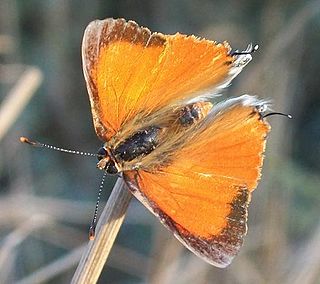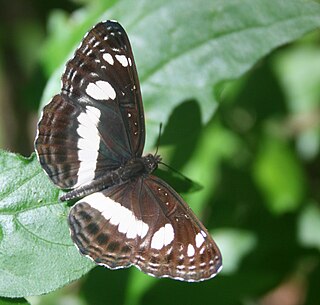
Axiocerses tjoane, the eastern scarlet, common scarlet or scarlet butterfly, is a butterfly of the family Lycaenidae. It is found in East and southern Africa.

Axiocerses amanga, the bush scarlet, is a butterfly of the family Lycaenidae. It is found in Sub-Saharan Africa.

Aeropetes is a monotypic butterfly genus in the family Nymphalidae. Its only species, Aeropetes tulbaghia, is commonly known as the Table Mountain beauty or mountain pride. It is native to southern Africa, where it occurs in South Africa, Lesotho, Eswatini and Zimbabwe.

Sarangesa phidyle, also known as the orange flat or small elfin, is a species of butterfly in the family Hesperiidae. It is found from Botswana, south-west Africa, Saudi Arabia, Sudan. In South Africa it is found from the eastern Cape to Eswatini, KwaZulu-Natal, Mpumalanga and the Limpopo Province, the North West Province and Gauteng.

Sarangesa seineri, also known as the dusted elfin or dark elfin, is a species of butterfly in the family Hesperiidae. It is found in South Africa, Botswana and from Zimbabwe to Kenya and the DRC.

Borbo fatuellus, the long horned swift, long horned skipper or foolish swift, is a butterfly of the family Hesperiidae. It is found in tropical Africa and south-western Arabia. The habitat consists of wet forests, moist woodland and coastal bush.

Precis octavia, the gaudy commodore, is a species of butterfly in the family Nymphalidae. It is native to Africa.

Alaena amazoula, the yellow Zulu, is a butterfly of the family Lycaenidae. It is found in southern Africa.

Iolaus silarus, the straight-line sapphire, is a butterfly of the family Lycaenidae. The species was first described by Hamilton Herbert Druce in 1885. It is found in Mozambique, Zimbabwe, Botswana, Namibia, Malawi, Zambia, southern Zaire, Tanzania, south-western Kenya and South Africa. In South Africa it is found in wooded savannah in northern KwaZulu-Natal and in savannah from Eswatini to Mpumalanga, Limpopo and North West. It is also present in Afromontane forest on the Wolkberg and the northern Drakensberg.

Deudorix dinochares, the apricot playboy, is a butterfly of the family Lycaenidae. It is found in South Africa, Madagascar, Zimbabwe, eastern Africa and south-west Arabia. In South Africa it is found from northern KwaZulu-Natal to Eswatini, Mpumalanga, Limpopo, North West and Gauteng.

Myrina silenus, the common fig-tree blue, is a butterfly of the family Lycaenidae. It is found in Sub-Saharan Africa, southern Arabia and northern Oman.

Lepidochrysops glauca, the silvery blue, is a butterfly of the family Lycaenidae. It is found from the African tropics to South Africa.

Eicochrysops hippocrates, the white-tipped blue, is a butterfly of the family Lycaenidae. It is found in Africa, south of the Sahara, including Madagascar. In South Africa it is found from the East Cape along the KwaZulu-Natal coast to Eswatini, Mpumalanga and the Limpopo province.

Cupidopsis cissus, the common meadow blue, is a butterfly of the family Lycaenidae. It is found in most of Africa, south of the Sahara.

Dixeia pigea, the ant-heap small white or ant-heap white, is a butterfly in the family Pieridae that is native to Africa.

Appias epaphia, the diverse white or African albatross, is a butterfly of the family Pieridae. It is found in Africa, south of the Sahara. The habitat consists of forests and heavy woodland.

Mylothris agathina, the eastern dotted border or common dotted border, is a butterfly of the family Pieridae. It is native to sub-Saharan Africa, particularly East Africa and southern Africa. In South Africa its range has spread westwards around the coast in the late 20th century, and it now occurs north of Cape Town to somewhat beyond Saldanha.

Byblia anvatara, the common joker, is a butterfly of the family Nymphalidae, found in Sub-Saharan Africa.

Eurytela hiarbas, commonly known as the pied piper, is a butterfly of the family Nymphalidae, found in Sub-Saharan Africa.

Neptis saclava, the spotted sailer, is a butterfly of the family Nymphalidae. It is native to Madagascar and to large areas of sub-Saharan Africa.

























